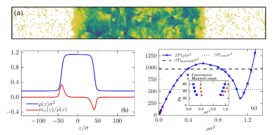
Dr. Siddharth Paliwal
Leonard S. Ornstein Laboratory, room 0.16
Princetonplein 1, 3584 CC Utrecht
P.O. Box 80 000, 3508 TA Utrecht
The Netherlands
phone: +31 (0)30 253 2467
secretariat: +31 (0)30 253 2952
e-mail: s.paliwal@uu.nl
Research
Promotor: Prof. dr. ir. Marjolein Dijkstra
Funding: Shell-FOM/NWO
Employed: 1 July 2015 – 30 June 2019
Computational study of Self-propelled particles
Self-propelled particles belong to a class of active systems that constantly convert energy into motion, resulting in a continuous dynamic reorganization of the constituents. A fascinating variety of non-equilibrium phenomena like swarming, lane formation, giant density fluctuations, clustering, vortices, etc. has been revealed by a number of synthetic and biological systems. Theoretical models of these systems, apart from the aforementioned novelties, have also been known to show equilibrium-like phenomena such as condensation, phase transition, crystallization etc. The recent research in the field has been towards explaining such behavior in terms of modified thermodynamic quantities.
We focus on the systematic study of collective behavior of these self-propelled particles using multi-particle Brownian dynamics simulations as a function of the relevant system parameters such as density, size, shape, self-propulsion speed and interactions of the nanoparticles. We implement a model system as a colloidal fluid interacting via Lennard-Jones or a repulsive pair potential and exhibiting self-propulsion and free rotational diffusion (also known as the Active Brownian Particle model) in both two and three dimensional periodic systems. We study various thermodynamic properties such as the states of phase-coexistence, mechanical pressure, interfacial tension [1] and chemical potential. Our results indicate that even though coexisting states display mechanical and diffusive equilibrium via modified pressure and chemical potential, these properties not only depend on the bulk state but also on the interfaces in such systems [2].
Figure 1: (a) Snapshot of simulation showing phase coexistence of repulsive Active Brownian particles in 2D (color indicates local density) (b) Density (blue) and Polarization (red) profiles, and (c) Pressure-density equation of state with the inset showing a comparison of the actual coexistence densities with the predictions from a Maxwell equal area construction.
[1] V. Prymidis, S. Paliwal, M. Dijkstra, L.Filion, JCP 145, 124904 (2016)
[2] S. Paliwal, J. Rodenburg, R. v. Roij, M. Dijkstra, NJP 20, 015003 (2017)

